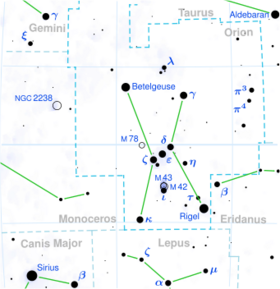Astronomy:Pi2 Orionis
| Observation data Equinox J2000.0]] (ICRS) | |
|---|---|
| Constellation | Orion |
| Right ascension | 04h 50m 36.72298s[1] |
| Declination | +08° 54′ 00.6493″[1] |
| Apparent magnitude (V) | 4.35[2] |
| Characteristics | |
| Spectral type | A1 Vn[3] |
| U−B color index | +0.03[2] |
| B−V color index | +0.01[2] |
| Astrometry | |
| Radial velocity (Rv) | 24[4] km/s |
| Proper motion (μ) | RA: +1.41[1] mas/yr Dec.: −29.91[1] mas/yr |
| Parallax (π) | 14.53 ± 0.38[1] mas |
| Distance | 224 ± 6 ly (69 ± 2 pc) |
| Absolute magnitude (MV) | 0.48[5] |
| Details | |
| Radius | 2.7[6] R☉ |
| Luminosity | 70[7] L☉ |
| Surface gravity (log g) | 4.00±0.05[8] cgs |
| Temperature | 9,457±128[8] K |
| Metallicity [Fe/H] | −0.20±0.10[8] dex |
| Rotational velocity (v sin i) | 261.4±13.5[5] km/s |
| Other designations | |
| Database references | |
| SIMBAD | data |
Pi2 Orionis (π2 Ori, π2 Orionis) is the Bayer designation for a solitary star in the equatorial constellation of Orion. Although the Bright Star Catalogue lists this as a spectroscopic binary star system,[10] this does not appear to be the case.[11] It is visible to the naked eye with an apparent visual magnitude of 4.35.[2] Based upon an annual parallax shift of 14.53 mas,[1] it is located roughly 224 light-years away from the Sun.
This is an A-type main-sequence star with a stellar classification of A1 Vn,[3] where the 'n' indicates broad absorption lines due to rotation. It is spinning rapidly with a projected rotational velocity of 261.4 km/s.[5] This is giving the star an oblate shape with an equatorial bulge that is 13% larger than the polar radius.[12] It is shining with 70[7] times the solar luminosity from its outer atmosphere at an effective temperature of 9,457 K.[8]
References
- ↑ 1.0 1.1 1.2 1.3 1.4 1.5 van Leeuwen, F. (2007), "Validation of the new Hipparcos reduction", Astronomy and Astrophysics 474 (2): 653–664, doi:10.1051/0004-6361:20078357, Bibcode: 2007A&A...474..653V.
- ↑ 2.0 2.1 2.2 2.3 Johnson, H. L. et al. (1966), "UBVRIJKL photometry of the bright stars", Communications of the Lunar and Planetary Laboratory 4 (99): 99, Bibcode: 1966CoLPL...4...99J.
- ↑ 3.0 3.1 Cowley, A. et al. (April 1969), "A study of the bright A stars. I. A catalogue of spectral classifications", Astronomical Journal 74: 375–406, doi:10.1086/110819, Bibcode: 1969AJ.....74..375C.
- ↑ Wilson, R. E. (1953), "General Catalogue of Stellar Radial Velocities", Washington (Carnegie Institute of Washington, D.C.), Bibcode: 1953GCRV..C......0W.
- ↑ 5.0 5.1 5.2 Ammler-von Eiff, Matthias; Reiners, Ansgar (June 2012), "New measurements of rotation and differential rotation in A-F stars: are there two populations of differentially rotating stars?", Astronomy & Astrophysics 542: A116, doi:10.1051/0004-6361/201118724, Bibcode: 2012A&A...542A.116A.
- ↑ Pasinetti Fracassini, L. E. et al. (February 2001), "Catalogue of Apparent Diameters and Absolute Radii of Stars (CADARS) - Third edition - Comments and statistics", Astronomy and Astrophysics 367 (2): 521–524, doi:10.1051/0004-6361:20000451, Bibcode: 2001A&A...367..521P.
- ↑ 7.0 7.1 McDonald, I. et al. (2012), "Fundamental Parameters and Infrared Excesses of Hipparcos Stars", Monthly Notices of the Royal Astronomical Society 427 (1): 343–57, doi:10.1111/j.1365-2966.2012.21873.x, Bibcode: 2012MNRAS.427..343M.
- ↑ 8.0 8.1 8.2 8.3 Wu, Yue et al. (January 2011), "Coudé-feed stellar spectral library - atmospheric parameters", Astronomy and Astrophysics 525: A71, doi:10.1051/0004-6361/201015014, Bibcode: 2011A&A...525A..71W.
- ↑ "pi.02 Ori". SIMBAD. Centre de données astronomiques de Strasbourg. http://simbad.u-strasbg.fr/simbad/sim-basic?Ident=pi.02+Ori.
- ↑ Hoffleit, Dorrit (1964), Catalogue of Bright Stars (3rd ed.), New Haven, Conn: Yale University Observatory, Bibcode: 1964cbs..book.....H.
- ↑ Eggleton, P. P.; Tokovinin, A. A. (September 2008), "A catalogue of multiplicity among bright stellar systems", Monthly Notices of the Royal Astronomical Society 389 (2): 869–879, doi:10.1111/j.1365-2966.2008.13596.x, Bibcode: 2008MNRAS.389..869E.
- ↑ Belle, G. T. (2012), "Interferometric observations of rapidly rotating stars", The Astronomy and Astrophysics Review 20 (1): 51, doi:10.1007/s00159-012-0051-2, Bibcode: 2012A&ARv..20...51V.
 |


